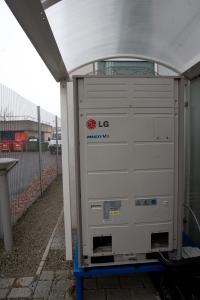The shape of things to come

Nick Ryman of LG believes the development of ever more sophisticated controls will enable air-conditioning and indoor climate control to achieve ever higher efficiencies through total building management; it is the shape of things to come.
Developments in building control systems have improved exponentially over the past few years as systems developers vie with one another to produce the most efficient solution. And air-conditioning manufacturers are not being left behind when it comes to developing technology, achieving ever more energy efficient outcomes. In fact, they are making a significant impact on the technology.
Previously efficiencies for air-conditioning systems were hampered by the lack of integrated controls, which meant the cooling system could be fighting the heating system. Of course, individually they work perfectly, but we now have to move beyond closed protocols and into controls that will work with open protocols. In effect, we need to get everything to work together in a more sympathetic way.
It is becoming clear that the future for the air-conditioning industry is to develop intelligent controls that can be easily assimilated into integrated buildings systems to ensure energy-efficient solutions. Centralised controllers provide building owners, facilities managers, and maintenance personnel with highly efficient control of VRF systems. This allows convenient management of air-conditioning units and other facilities equipment, even in multiple sites, and importantly, delivers considerable energy efficiencies at the same time.
In 2009 Jeremy Towler, a BSRIA senior manager for energy and smart technologies, predicted: ‘As energy costs continue to fluctuate wildly, it is increasingly important for all organisations to monitor and improve their energy consumption. Along with tougher energy legislation, the cost of energy is creating a carrot-and-stick environment that is driving improvements in energy efficiency. Consequently, the non-residential intelligent building control market is forecast by BSRIA Proplan to continue its growth at a healthy rate despite the difficult current economic climate.’
At the time he explained that collectively, the non-residential building controls market in the largest seven economies in Europe (UK, France, Germany, Italy, Spain, Belgium and the Netherlands) reached €2.7 billion in 2007. The UK market was valued at £428 million and forecast by BSRIA Proplan to reach at least £441 million by 2012. This represented a growth of approximately 3% (in real terms).
Things have moved on apace since then. In May 2013 this year Jeremy Towler comments in a blog on the BSRIA website that these new technologies are now utilising ‘the Cloud’ for self-diagnosis and adjustment functionality not previously available in a building automation and control system (BACS). He says suppliers are now faced with the reality ‘If I am not in the cloud, my competitors probably will be’.

And, he goes on to add: ‘We have looked (BSRIA report ‘Smart buildings and technology trends’, May 2013) at how the BACS-equipped VRF systems in the $9 billion VRF market are affecting the HVAC and BACS markets. Since VRF-based systems are becoming ever more ‘intelligent’ this changes the scope for building automation. Incumbents must be asking themselves ‘how long until they start offering the same sort of capabilities as high-level BACS?’.
The report notes an aggressive upturn in the adoption of BACS systems with open standard communication protocols (OSCP), leading to further integration of building functions including cooling. It charts a rise from 40% in 2004 to 70% in 2012, and forecasts OSCP will rise to at least 80% by 2017. ‘In the 27 EU countries only one in five buildings have BACS, and these are generally in medium to large buildings, so there is a large untapped opportunity to retrofit medium to small buildings. An important conclusion is that a large number of non-residential buildings do not have BACS or BEMS,’ the report concludes.
It is inevitable that demand for this energy-efficient technology will increase in the light of the approaching revised 2013 Part L Building Regulations, which is almost certainly going to require renewable technology in new commercial buildings to meet the Government’s new-build emission targets for commercial projects.
At the same time, minimum system efficiencies recommended in the non-domestic building services compliance guide now call for most air-conditioning systems to up their ESEER from 2.5 to 2.7, while maximum SFPs have all been incrementally reduced by 0.1 to 0.3 W/l/s, although it may well be necessary to exceed these minimum efficiencies to comply with CO2 targets.
Nick Ryman is air-conditioning and energy solutions-general manager at LG.







